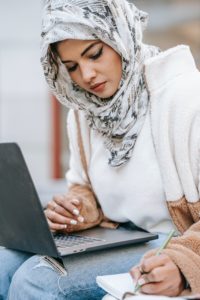Survey of Secondary Writing Instruction

Dear teachers,
Are you curious about the current state of writing instruction in middle and high schools with deaf and hard of hearing students? We are, too!
If you are currently teaching writing or have taught writing to middle and high school students in the past, you are in an ideal position to give us valuable first-hand information about your experiences. We would love to hear from you! You are welcome to share this with your colleagues as well.
This survey takes approximately 10-15 minutes to complete.
To show our appreciation, you may enter into a drawing to win a $20 Amazon gift card (20 available).
Sincerely,
Kimberly Wolbers, PhD, University of Tennessee kwolbers@utk.edu
865-974-2375
Hannah Dostal, PhD, University of Connecticut hannah.dostal@uconn.edu
865-292-4219
Leala Holcomb, PhD, University of Tennessee lholcom5@vols.utk.edu
415-307-6410
About the Authors
Kimberly A. Wolbers, Ph.D., University of Tennessee
Kimberly A. Wolbers is a Professor of the Education of the Deaf and Hard of Hearing program at the University of Tennessee. She earned her PhD from Michigan State University in 2007 with a focus in special education and literacy.
Her research has focused on the design and implementation of writing and language instruction for deaf and hard of hearing children and adolescents. She has conceptualized an approach called Strategic and Interactive Writing Instruction (SIWI), which aims to be responsive to the varied language needs of deaf learners. SIWI draws upon evidence-based approaches to teaching writing such as strategy instruction in writing and collaborative, interactive writing. SIWI also contains language-specific elements that provide teachers with direction on how to, for example, navigate between ASL and English when teaching developing bilinguals, or facilitate greater expressive language clarity and complexity among children with language delays. There is growing evidence to suggest SIWI has a positive impact on students’ expressive language, word identification, motivation, and writing outcomes at the word-, sentence-, and discourse-levels. Recent SIWI publications and grants are listed on the University of Tennessee’s Web site.
Hannah M. Dostal, Ph.D., University of Connecticut
My research focuses on writing instruction for deaf and hard of hearing (DHH) students and teacher professional development in literacy. In particular, I examine Strategic and Interactive Writing Instruction as an intervention for DHH students with varied language histories. In addition, I investigate the role of genre and literacy instruction in the development of disciplinary knowledge and discipline-specific communication patterns. My current research is funded by the Institute for Education Sciences (IES), and has previously been funded by IES, State Teacher Quality Grant partnerships, the International Literacy Association, and the Connecticut Department of Education.
I currently serve as an associate editor of the Journal of Deaf Studies and Deaf Education and as co-editor of The Oxford Handbook of Deaf Studies in Literacy. I am also an active member of several professional societies including the American Educational Research Association, Literacy Research Association, Association of College Educators-Deaf and Hard of Hearing, and the International Literacy Association.
My teaching is informed by my experience as a middle school language arts teacher and writing intervention coordinator at a state school for the deaf. My approach to undergraduate and graduate teaching is focused on designing learning environments with an explicit focus on equitable access to instruction, strategic interaction, and the development and use of multiple and specific literacies. Beyond the classroom, I have been active in developing a graduate certificate in literacy and deaf education as well as a concentration in American Sign Language (ASL) education to meet the growing need for ASL teachers in Connecticut secondary schools.
About the Louisiana Deafblind Project
The mission of the Louisiana Deafblind Project for Children & Youth is to provide technical assistance and information dissemination to Louisiana students with combined hearing and vision loss, their families, schools, service providers, school districts, and the Louisiana Department of Education.

 myLSUHSC
myLSUHSC